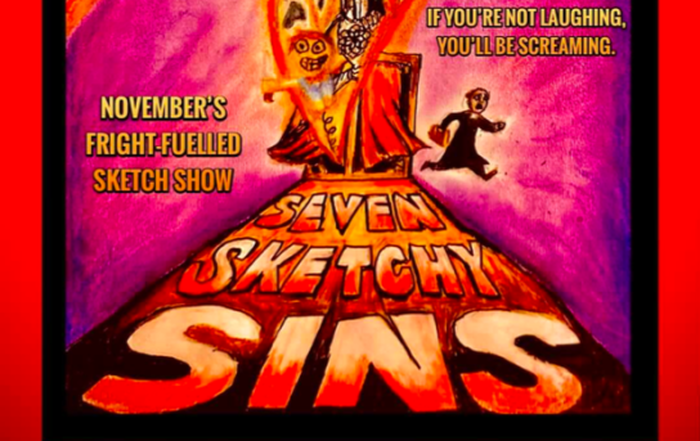5/11: A radical remix of post-modern punk and political anarchy
Beatrice Coulter explores the intersections between power, punk and the Gunpowder plot

Sometimes the aesthetics of a show are artistically formative in themselves; I have a soft spot for such productions that are highly stylised and take big chances. Walking into 5/11, I was excited to see Robert Cecil sat, bathed in red light, in front of a dying Queen Elizabeth, and I thought to myself, “I really hope they nail it.”
It did not disappoint.
The production design is nothing short of spectacular. The costumes designed by Freya Cowan and Lucy Wright are incredible and unlike anything that has ever been seen on the ADC stage. Honestly, I would recommend seeing the show just for the costumes. Highlights include the ‘Britannia’ dress and Robert Catesby’s jacket, which both capture two very different ideas of what ‘punk’ fashion can be. But this extends outwards, with the makeup as well creating a very visually striking image that really nails the vibe that the director was going for. The set design is likewise outstanding, with the throne centre stage illuminating the king’s enduring presence in every scene.
“The production design is nothing short of spectacular”
This also extends to the technical aspects of the show. The lighting design by Gwendolen Sellers is highly stylised, working in perfect lockstep with the production design to really give the feeling that you are at a punk rock show, with all the color and intensity that this would entail. Similarly, the sound design effortlessly works punk classics alongside the roaring intensity of a crowd or a torturing. I do not know how else to put it, but this is a superbly designed show.
The acting is phenomenal across the board. A real standout is Joe Orell as King James, who manages to portray the real bravado of the king, as well as the emotional vulnerability at his core. But great performances are given across the leads. Eanna Fergurson is very good at showing the eternally conflicted Henry Garnet whilst Charlie Morgan shows the high minded idealism of Robert Catesby, and their conflict and chemistry really helps to drive the show. Sam Thompson’s eerie and controlled performance as Robert Cecil oozes the right level of contempt and dominance that allows him to seem so evil at times, yet so pathetic at others. Likewise, the large ensemble cast is very good, with particular highlights being Zac Lonberg, Alice Roberts, Lizzy Riley, and Rob Monteiro, all of whom have at least one memorable moment that really shows the way they inhabit their characters.
“The acting is phenomenal across the board”
However, it would be remiss not to mention that despite a fast-paced opening that hits the ground running with a lot of energy, the play tends to drag, particularly after the interval. The initial momentum of the play is lost as it enters some of the meatier and emotionally intense scenes. This is not necessarily a bad thing, but the direction engenders a weird feeling of stasis which led to a sense that the show itself was losing steam. This is true particularly after the plot fails and the conspirators are left to deal with the aftermath. I cannot exactly pinpoint it to one thing exactly, but the second half does drag in contrast to the high energy first half which creates a lot of momentum behind it.
But one thought that I keep coming back to (for which I expect you to disagree) is that despite how well done its embrace of punk is, I am not really sure what it contributes to the play’s essential message. And in doing so, the play raises an interesting question about what punk exactly is, particularly who can lay claim to it. For example, Evie Chandler uses punk to try and draw an analogy between the radicalism of the 1600s and the radicalism of today. But I am not really sure to what extent a bunch of aristocrats trying to restore papal authority in England can be compared to a youth counter-culture movement striving for Anarchism. Particularly given that Catholicism at the time was seen as the conservative force, mostly maintained by older generations who wanted a return to the old way of doing things. The young radicals were arguably protestants in England trying to create a more reformed church. In part, Chandler tries to equate today’s political radical movements to the punk movement and the Gunpowder plot itself, but I can’t help but wonder what this really adds. To me, it seems a rather tenuous link, as Punk emerged out of a very specific set of circumstances, which I find hard to compare to the Gunpowder Plot and to have the comparison of those events to speak to the present day I think tries to do too much. While I certainly appreciate Chandler’s aesthetic vision, I personally struggle to make such figurative leaps between the events.
Likewise, it is an interesting choice to include figures of power embracing the vision of punk as purely aesthetic excess. By having those in power also in that style, it ends up obscuring Chandler’s sentiment; it’s not that punk deliberately lost its meaning, it’s that it became redundant. Chandler attempts to use punk to draw a temporal analogy between then and now, but to my mind, she seems to fall into the same trap as the ‘gentrifiers’ of punk, in embracing its aesthetics, devoid of the actual meaning and history of it.
But this is my opinion. See the show for yourself and make up your own mind. If there is one thing that the play wants you to take away from it, is that you should make your choices, think freely and be radical. Love it or hate it, you will be treated to one of the best designed shows I have seen in Cambridge.
5/11 is showing at the ADC Theatre from 7-11 November at 7:30pm.
 News / SU reluctantly registers controversial women’s soc18 December 2025
News / SU reluctantly registers controversial women’s soc18 December 2025 Features / Should I stay or should I go? Cambridge students and alumni reflect on how their memories stay with them15 December 2025
Features / Should I stay or should I go? Cambridge students and alumni reflect on how their memories stay with them15 December 2025 News / Dons warn PM about Vet School closure16 December 2025
News / Dons warn PM about Vet School closure16 December 2025 News / Cambridge study finds students learn better with notes than AI13 December 2025
News / Cambridge study finds students learn better with notes than AI13 December 2025 News / Uni registers controversial new women’s society28 November 2025
News / Uni registers controversial new women’s society28 November 2025









